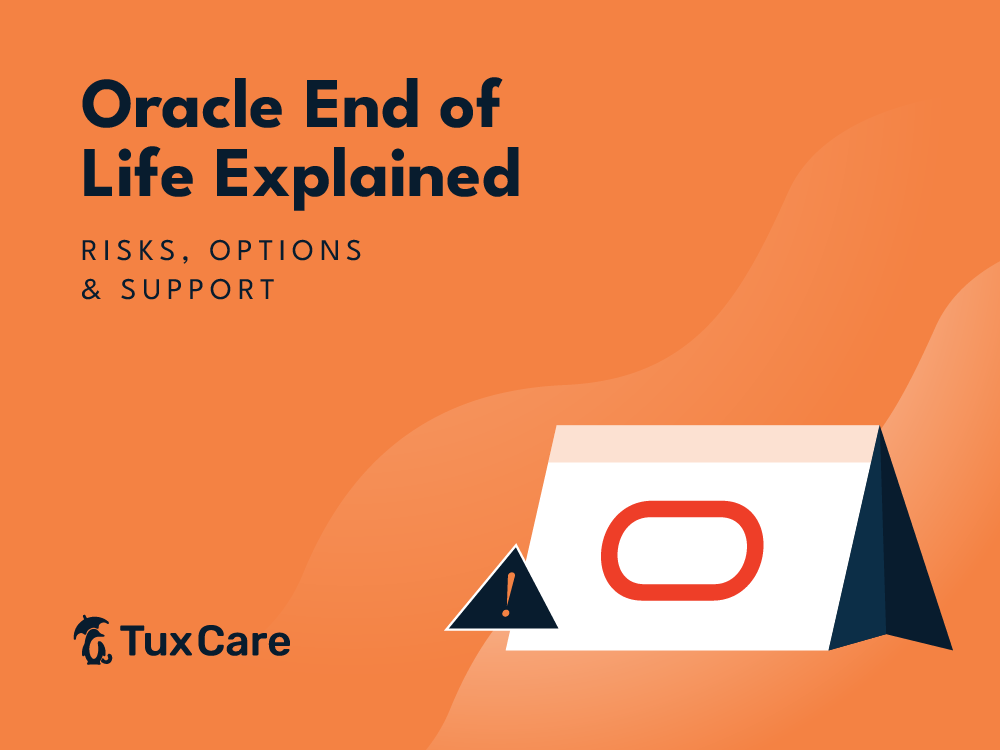Key Takeaways
- Oracle Linux End of Life (EOL) means no more official security patches or updates. This leaves your systems vulnerable and non-compliant.
- Organizations can upgrade, migrate, or extend security. This includes options from Oracle’s Extended Support or affordable alternatives like TuxCare.
- TuxCare’s Endless Lifecycle Support (ELS) provides ongoing security patching for End-of-Life Oracle Linux 6 and 7 for as long as you need.
If you’re running Oracle Linux past its End of Life (EOL), your infrastructure is exposed.
Once Oracle declares EOL, security patches, bug fixes, and maintenance updates are gone — putting your systems at critical risk.
In this article, you’ll learn what Oracle End of Life really means, why it’s risky to delay action, and how to keep your Oracle Linux EOL systems secure and compliant — even after official support ends.
What Does Oracle End of Life Really Mean?
End of Life (EOL) marks the point when Oracle stops delivering all security patches, bug fixes, and maintenance updates. Most organizations hit this milestone after Premier Support ends, followed by expensive Extended Support, and finally Sustaining Support — which provides no new security fixes. This applies across Oracle databases, middleware, and enterprise applications.
When Oracle Linux enters EOL, you face immediate and severe risks of compromise and non-compliance.
- Unpatched Vulnerabilities: No protection against new CVEs — attackers know you’re exposed.
- Compliance Failures: Unsupported systems can violate HIPAA, PCI-DSS, ISO 27001, GDPR, and others.
Why Oracle Linux Reaches End of Life
Like all vendors, Oracle retires older versions to reduce legacy support overhead. Over time, maintaining outdated kernels, drivers, and toolchains becomes resource-heavy and less sustainable — especially when backporting patches or ensuring compatibility with modern hardware. Oracle Linux follows a tiered lifecycle:
- Premier Support: Full support and updates
- Extended Support: Limited security fixes
- Sustaining Support: No new security fixes
Key Impacts of Oracle Linux EOL on Businesses
For organizations still running EOL software like Oracle Linux 6 or Oracle Linux 7, letting these systems drift past EOL triggers more than just a loss of vendor support — it brings real-world risk across security, compliance, and day-to-day operations. This is similar to the challenges seen during the end of life of oracle 18c, where delayed transitions led to heightened vulnerability and operational risk.
Security Risks from Unpatched Systems
After EOL, Oracle stops releasing kernel updates and security patches for Oracle Linux — even for critical vulnerabilities. This leaves servers exposed to known exploits. For organizations subject to stringent data protection and security frameworks like HIPAA, PCI DSS, ISO 27001, or GDPR, running unpatched systems can trigger compliance violations.
Rising Costs for Extended Support
Oracle’s Extended Support for Linux is expensive and limited. Many enterprises find themselves paying more for less frequent patching, often with tight restrictions on what fixes are provided. In some cases, the cost of maintaining EOL systems through Oracle doesn’t justify the cost — especially when alternatives like TuxCare’s Endless Lifecycle Support (ELS) exist that offer comprehensive security patching at a lower price.
Operational & Compatibility Challenges
As Oracle Linux ages, it increasingly struggles to integrate with newer hardware, container runtimes, and DevOps tooling.
Teams face performance slowdowns, dependency conflicts, and blocked upgrades, making it hard to modernize infrastructure or adopt automation frameworks securely.
How to Prepare for Oracle Linux End of Life
If you’re running Oracle Linux 6 or 7, now is the time to act. Waiting until a critical system fails — or a CVE gets exploited — isn’t a secure strategy. Here’s how to take control, minimize disruption, and ensure your systems remain secure and compliant post-EOL.
Take Inventory and Assess Current Oracle Deployments
Start by mapping every Oracle Linux instance in your infrastructure.
Identify which systems are running Oracle Linux 6 or Oracle Linux 7 — and flag them by their criticality to your business operations.
This risk-based assessment is crucial for prioritizing your strategy: which systems absolutely must be upgraded or migrated, which can leverage extended support, and which can potentially be retired.
Explore Upgrade or Migration Options
Once you understand your current landscape, explore the direct paths forward. Each comes with its own set of challenges and benefits:
Upgrading to Oracle Linux 8 or 9: Oracle’s direct recommendation, providing access to the latest features and Premier Support. However, this is a significant undertaking requiring substantial planning, testing, potential application re-certification, and likely downtime.
Switching to Other Enterprise Linux Distributions: Options like AlmaLinux or Rocky Linux can offer long-term support and community benefits. This is often the most disruptive option, requiring complete revalidation, application re-platforming, and considerable downtime.
Consider Third-Party Oracle Linux Support
For many organizations, third-party support offers the best of both worlds: continued security patching without the cost or complexity of migrating. TuxCare’s Endless Lifecycle Support (ELS) extends the life of Oracle Linux 6 and Oracle Linux 7 with ongoing CVE patches for a comprehensive list of essential server packages, and for as long as needed. This support can be provided for as long as your business needs it, offering unparalleled flexibility.
To see the list of all packages covered, check out the TuxCare’s CVE tracker page.
Oracle EOL Policies: What You Need to Know
Oracle’s Product Lifetime Support Policy defines how long its software — including Oracle Linux and other offerings — receive official updates, patches, and assistance. Each major release typically goes through three phases:
Premier Support: Full coverage, including new features, patches, and technical support.
Extended Support: Offers limited patches and fixes beyond Premier Support.
Sustaining Support: No new fixes or security updates.
Avoiding Downtime: Best Practices for a Smooth Transition
Transitioning from Oracle Linux 6 or 7 doesn’t have to mean disruption.
With proactive planning and the right strategies, you can maintain stability, protect critical systems, and ensure business continuity throughout your End-of-Life (EOL) journey.
Start Early with a Risk-Based Transition Plan
Begin well before your EOL deadline. Build a detailed timeline and identify mission-critical systems tied to Oracle Linux. Involve stakeholders across security, compliance, DevOps, and infrastructure. Use test environments to validate upgrades or support alternatives — don’t leave this to the last minute.
Safeguard Data and Business Continuity
Before any changes, confirm you have full, verified backups. Test your disaster recovery procedures to ensure rapid rollback if something breaks. Run performance tests post-migration to catch hidden issues early, especially for workloads under high I/O or uptime requirements.
Evaluate Support Options Carefully
Oracle’s Extended Support can be costly and limited. Consider solutions like TuxCare’s ELS for Oracle Linux 6 and Oracle Linux 7 — a cost-effective alternative that offers ongoing vulnerability patching for as long as needed after the vendor-supported lifecycle.
Document Everything and Verify Compliance Impact
Track every change and decision during your EOL transition. Document how your approach aligns with frameworks like HIPAA, PCI DSS, ISO 27001, and GDPR. This improves audit readiness, ensures cross-team clarity, and strengthens your organization’s overall security posture.
Oracle EOL Isn’t the End: Stay Protected with TuxCare
The End of Life for Oracle Linux 6 and Oracle Linux 7 doesn’t have to mean a costly, disruptive “rip and replace.” With TuxCare’s Endless Lifecycle Support (ELS), your organization can continue running these systems securely, compliantly, and without downtime — all while avoiding Oracle’s premium Extended Support costs or rushed migrations.
TuxCare delivers continuous CVE-based security patches for your Oracle Linux kernels and other essential packages. This provides a stable and secure bridge, giving your team the crucial time needed to strategically plan and execute your next move without compromising security or operational continuity.
Read our article on The Risks of Running an End Of Life OS – And How To Manage It to understand the broader security and compliance implications.



 Documentation
Documentation Login
Login





